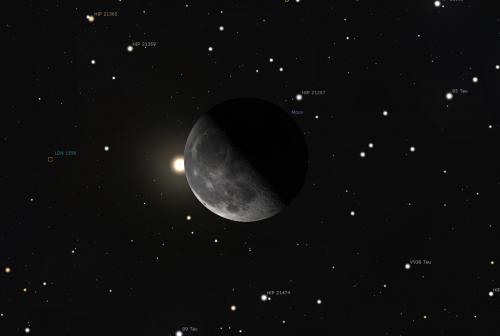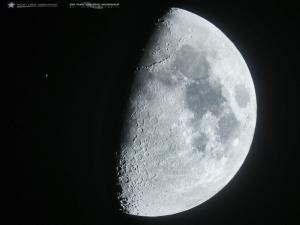Occultation of Aldebaran
As the Moon orbits the Earth once every 29.5 days, each day it moves eastward in our sky at 12.2 degrees per day. It may not be obvious to most people, but along the way the Moon’s disk covers and uncovers stars as it passes in front of them. And because the Moon strays no more than five degrees north or south of the Sun’s path in the sky (called the ecliptic, or plane of our solar system), the Moon may occasionally pass in front of a planet or minor planet (asteroid) as well. These events are called occultations.
There are some bright stars on or near the ecliptic that are occulted more frequently. One of those is reddish Aldebaran, the brightest star in the constellation of Taurus. And coming up during the night of September 4-5, a Last Quarter Moon will occult this star.
There events are interesting to observe, as one can watch as the star slowly disappears behind the limb of the Moon. This time Aldebaran will disappear behind the Moon’s bright limb (left hand side) at around 11:56 p.m. The lunar disk will continue to hide Aldebaran for about 45 minutes. Then it will reappear at approximately 12:41 a.m. along the Moon’s dark limb (right hand side).
While this is an easy event to observe with just your eyes, binoculars or a telescope will definitely enhance the view. However, there is a degree of difficulty in observing this occultation. And that is the fact that the event begins with the Moon just 5.5 degrees above the eastern horizon. You’ll need an unobstructed view. No trees. No houses to block your view. Anywhere along the coast affords this kind of horizon. When Aldebaran reappears the Moon will then only be about 13 degrees above the horizon. A fist held at arm’s length provides a sky measurement of ten degrees, so this will give you some idea of just what to look for when choosing a location to witness this event.
Try to snap a few camera images using a telephoto lens if you do not have more sophisticated equipment. Or, simply enjoy the celestial show. You’ll only have to make a small commitment of time on a Friday night to a little past midnight.
Good luck and cross your fingers for cloud-free skies.
Dave Huestis
- Author:
- David Huestis
- Entry Date:
- Sep 3, 2015
- Published Under:
- David Huestis's Columns



